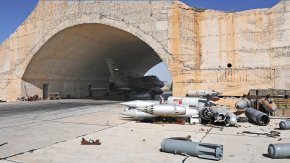Such shelters are terribly vulnerable to the USAF when they have complete air superiority over the top of them, few range and time on station issues, can bring virtually any weapon and as many aircraft as they like to do so and can spend as long as they like and hit it as many times as they like to ensure they kill it.
Which is a very different scenario than we face. If any enemy has such freedom of action over our bases, it will not matter what we try and do to them, just as it didn’t in Iraq.
Given vastly different range, environmental and (hopefully) military capacity issues, one might suspect a rather different operational environment that is more akin to long range missile strike. As we saw in 2017, when 59x 1000lbs warhead class missiles were operationally employed against a single airbase from range, hardened shelters provided substantial defensive resilience…
No-one measure is going to prove totally effective. A mix I rather think is required. Defensive fortifications however retain a place on most battlefields, according to most nations around the world.
View attachment 50491

